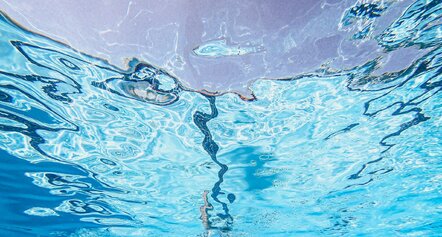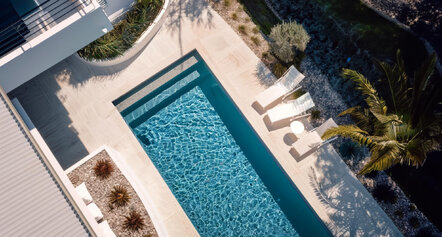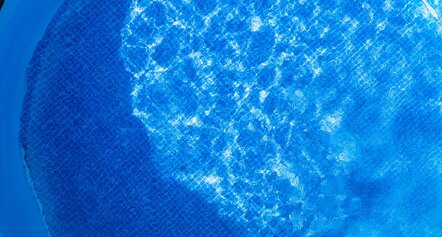Saltwater pools have surged in popularity across Australia, with nearly one in three households opting for this modern alternative to traditional chlorine pools. However, many pool owners encounter issues such as rapid chlorine loss, particularly in the intense Australian sun. This problem often stems from a lack of proper stabilisation.
Pool stabilisers, primarily cyanuric acid, protect chlorine from UV degradation. In saltwater systems, where chlorine is generated on-site, stabilisers ensure that the chlorine remains effective for longer periods, maintaining the water’s cleanliness and balance.
Understanding stabilisers is crucial for saltwater pool owners who want a safe and comfortable swimming environment. Without proper stabilisation, water chemistry can quickly become imbalanced, leading to higher maintenance costs and potential damage to equipment. Embracing proper stabiliser practices allows pool owners to enjoy crystal-clear water all year round with less hassle.
Understanding Saltwater Pools and Water Chemistry Basics
Saltwater pools use a salt chlorinator to generate chlorine from dissolved salt, offering a gentler and more consistent alternative to traditional chlorine pools. Unlike manually adding chlorine, saltwater systems produce chlorine continuously, maintaining water clarity and sanitation without the sharp chemical odours often associated with traditional pools.

Maintaining water chemistry is fundamental for the effective operation of a saltwater pool. Key parameters include:
- pH levels should remain between 7.2 and 7.6 for optimal swimmer comfort and chlorine efficiency.
- Typically maintained at 2500–4500 ppm, salinity ensures the chlorinator functions appropriately.
- The ideal range for alkalinity is approximately 60–120 ppm. Remember that higher alkalinity levels make it more challenging to adjust pH, whether increasing or decreasing. Calcium hardness should be maintained at a minimum of 250 ppm.
Consistent water chemistry is vital for creating a safe and enjoyable swimming experience. Imbalances can lead to skin and eye irritation, cloudy water, and damage to the chlorinator, pump, and other equipment.
For instance, high pH reduces chlorine’s sanitising power, while low salinity can strain the chlorinator, shortening its lifespan. Regular testing and adjustments keep these elements in balance, ensuring swimmer comfort and protecting your investment in pool equipment.
Saltwater pools combine modern convenience with superior water quality, but understanding their unique chemistry is key to achieving the best results.
What Are Saltwater Pool Stabilisers?
Saltwater pool stabilisers are essential chemical compounds designed to preserve chlorine’s effectiveness in maintaining clean and balanced water. The primary stabiliser used in pools is cyanuric acid (CYA), a chemical that interacts with chlorine to shield it from the damaging effects of ultraviolet (UV) rays. Without stabilisers, chlorine in a saltwater pool can break down rapidly under sunlight, leaving the water vulnerable to bacteria and algae growth.
Stabilisers form a protective bond with free chlorine molecules when added to a pool. This bond slows the degradation process caused by sunlight, allowing the chlorine to remain active for longer. As a result, stabilisers help maintain consistent sanitation levels, reducing the need for frequent chlorine adjustments.
Achieving the right stabiliser balance is crucial. If levels are too low, chlorine is depleted too quickly, compromising water quality. On the other hand, excessive stabilisers can lead to "chlorine lock," where chlorine becomes less effective at killing pathogens.
To achieve optimal performance, a cyanuric acid level of 30–50 ppm is generally recommended for saltwater pools. Regular testing and adjustments ensure stabilisers work effectively, supporting a safe and pleasant swimming environment.
Effects of Stabilisers on Pool Water Chemistry

Chlorine Protection
Stabilisers play a vital role in extending the lifespan of chlorine in saltwater pools. The active ingredient, cyanuric acid, forms a protective bond with free chlorine molecules, shielding them from rapid degradation caused by UV rays. Without stabilisers, up to 90% of chlorine can break down within hours under direct sunlight, leaving the pool vulnerable to bacteria and algae.
Stabilisers ensure adequate sanitation and reduce the frequency of chlorine generation or supplementation, saving time and effort. This protection is especially crucial in Australia’s sunny climate, where UV exposure is consistently high.
pH Balance and Other Chemicals
Stabilisers indirectly support pH balance and the overall chemical equilibrium in saltwater pools. When chlorine levels remain stable due to the presence of stabilisers, fluctuations in pH levels are minimised. This helps maintain the ideal pH range of 7.2 to 7.6, which is critical for swimmer comfort and the efficient performance of chlorine.
Consistent stabilisation also reduces stress on other chemicals, such as alkalinity and calcium hardness, preventing the need for constant adjustments. A well-stabilised pool operates more efficiently, keeping water clarity intact and extending the lifespan of pool equipment like pumps and filters.
Risks of Over-Stabilisation
Excessive stabiliser levels can lead to significant issues in saltwater pools. When cyanuric acid concentrations exceed recommended ranges, chlorine effectiveness decreases, resulting in a condition often called "chlorine lock." This weakens the pool’s defence against bacteria and algae, increasing the likelihood of murky water and outbreaks.
High stabiliser levels can also cause imbalances in water chemistry, making it harder to maintain pH and alkalinity. Addressing over-stabilisation often requires diluting the pool water or performing partial drainage, which can be time-consuming and costly. Regular testingis essential to avoid these complications and ensure optimal stabiliser levels.
Maintaining the Right Stabiliser Levels
Testing Stabiliser Levels
Accurate testing of stabiliser levels is crucial to maintaining a balanced saltwater pool. Use a reliable pool test kit or test strips to measure cyanuric acid (CYA) levels. Collect a water sample from elbow depth and follow the kit instructions, which typically involve mixing the sample with a reagent to observe cloudiness.
Compare the result against the provided scale to determine the CYA concentration. Regular testing, ideally every two weeks during peak pool usage, helps identify fluctuations. Consistent monitoring ensures stabilisers are within the optimal range, protecting chlorine effectiveness and preventing chemical imbalances.
Ideal Stabiliser Range
The ideal cyanuric acid range for saltwater pools is typically 30–50 ppm. This balance protects chlorine from UV degradation while maintaining its sanitising power. Pools exposed to intense sunlight may benefit from slightly higher levels, up to 70 ppm, but exceeding this range can reduce chlorine efficiency.
Factors influencing stabiliser levels include:
- Pool size
- Sunlight exposure
- Frequency of water dilution, such as rain or backwashing
Maintaining levels within this range ensures water clarity and safety while minimising potential issues like algae growth or reduced chlorine activity. Regular testing and adjustments are key to achieving these ideal conditions.
Adjusting Stabiliser Levels
To lower stabiliser levels, partially drain and refill the pool with fresh water, as cyanuric acid does not naturally dissipate. Test the levels after refilling to ensure they are within the recommended range. If levels are too low, add a cyanuric acid product according to the manufacturer’s guidelines, distributing it evenly across the pool while the pump runs.
Allow the stabiliser to dissolve fully and retest the water after 24 hours to confirm the adjustment. Properly balancing stabiliser levels ensures effective chlorine performance and reduces the need for frequent chemical corrections.
Common Myths About Saltwater Pool Stabilisers

A common misconception is that saltwater pools do not require stabilisers because they generate chlorine through a salt chlorinator. While saltwater systems continuously produce chlorine, the chlorine is still susceptible to rapid breakdown under UV rays without the protection of a stabiliser like cyanuric acid. Maintaining sufficient chlorine levels in sunny conditions becomes a constant challenge without stabilisers, reducing water quality.
Another widespread myth is that using stabilisers excessively enhances their benefits. In reality, overuse can hinder chlorine’s ability to sanitise effectively, a condition often called "chlorine lock." This can result in murky water and increased vulnerability to bacteria and algae growth.
Some believe stabilisers are ineffective in reducing chlorine usage. However, stabilisers significantly extend chlorine’s lifespan when maintained at proper levels, reducing its consumption. Understanding the correct use of stabilisers is key to achieving a well-maintained and efficient saltwater pool.
Benefits of Proper Stabilisers in Saltwater Pools
Using stabilisers correctly in saltwater pools delivers a range of benefits that enhance pool performance and user satisfaction:
- Improved Water Clarity: Stabilisers protect chlorine from UV degradation, helping maintain consistent sanitisation and crystal-clear water.
- Reduced Chlorine Consumption: With stabilisers extending the lifespan of chlorine, less chlorine is required to keep the pool sanitised, lowering overall chemical costs.
- Enhanced Swimmer Comfort: Balanced stabiliser levels prevent excessive chlorine spikes, reducing skin and eye irritation for swimmers.
Long-term Advantages for Pool Equipment and Maintenance:
- Prolonged Equipment Lifespan: Consistent water chemistry reduces stress on pool components like pumps, filters, and chlorinators, extending their operational life.
- Lower Maintenance Efforts: Proper stabilisation minimises the need for frequent chemical adjustments, saving time and effort.
- Cost Savings: Reduced chlorine usage and less wear on equipment translate to significant financial benefits over time.
Balance Your Pool, Balance Your Life
Proper stabiliser levels are essential for achieving a clean, safe, and efficient saltwater pool. Stabilisers protect chlorine from UV degradation, ensuring consistent sanitation and clear water. Proper balance prevents over-stabilisation, which reduces chlorine effectiveness and leads to problems like algae growth. Regular testing and adjustments help preserve water chemistry, minimise maintenance, and prolong the lifespan of pool equipment.
Flamingo Pools is your trusted partner for all saltwater pool needs. With extensive experience and expertise, Flamingo Pools specialises in stabiliser testing, adjustments, and comprehensive pool care. Their team understands the unique challenges of maintaining saltwater pools, especially under Australia’s intense sun, and offers tailored solutions to keep your pool in top condition year-round.
Whether you’re looking for routine maintenance, expert advice, or help balancing your pool’s stabiliser levels, Flamingo Pools is here to assist. Contact Flamingo Pools today for professional support and enjoy peace of mind with a perfectly balanced, hassle-free saltwater pool. Experience the benefits of clear water, reduced chemical use, and a pool that’s always ready for a refreshing swim.




